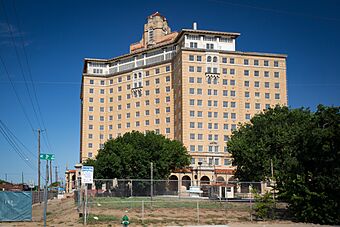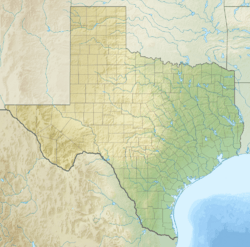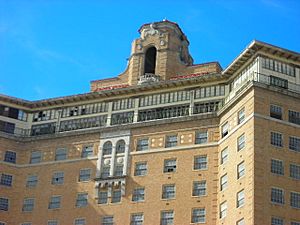Baker Hotel (Mineral Wells, Texas) facts for kids
Quick facts for kids |
|
|
Baker Hotel
|
|

The Baker Hotel in July 2023
|
|
| Location | 201 E. Hubbard St., Mineral Wells, Texas |
|---|---|
| Area | less than one acre |
| Built | 1929 |
| Built by | Inge & Burger, Inc. |
| Architect | Wyatt C. Hedrick |
| Architectural style | Chicago School Mission Revival Spanish Colonial Revival |
| Website | https://thebakerhotelandspa.com |
| NRHP reference No. | 82004518 |
| Added to NRHP | June 23, 1982 |
The Baker Hotel is a famous old hotel located in Mineral Wells, Texas. It was added to the National Register of Historic Places in 1982. This means it's an important building with a lot of history! People once came from all over to visit Mineral Wells for its special mineral water, and the Baker Hotel was the place to stay.
Contents
History of the Baker Hotel
How the Baker Hotel Began
The idea for the Baker Hotel started in 1922. People in Mineral Wells wanted to build a big, fancy hotel. They wanted local people to own it. They raised $150,000 to make this dream happen.
They asked a famous hotel builder, Theodore Brasher Baker, for help. He had designed other grand hotels. The hotel's design was inspired by the Arlington Hotel in Arkansas. That hotel was also known for its water and baths.
Construction started in 1926. But then, Mr. Baker saw a hotel in California with a swimming pool. He decided the new Baker Hotel needed one too! So, they added an Olympic-sized pool. It was the first hotel in Texas to have such a pool. This pool was filled with the town's famous mineral waters.
The hotel was a huge building, 14 stories tall. It had 450 guest rooms, two ballrooms, a beauty shop, a bowling alley, and a gym. It cost $1.2 million to build and opened in 1929. The Baker Hotel quickly became the tallest building in Mineral Wells.
The 1930s: A Popular Spa Spot
The Baker Hotel officially opened on November 9, 1929. A big party was held two weeks later. It had amazing features for its time. There was a system that sent ice water to every room. Lights and fans turned on and off automatically when guests entered or left. There was even a special compartment for laundry that staff could access without entering the room!
By the 1940s, the hotel had air conditioning. This made it even more popular for big meetings. It could host 2,500 people, which was a lot for a town of only 6,000 residents. Even though it opened right after the 1929 stock market crash, the hotel did very well. This was because Mineral Wells was known as a top health spa.
Many famous people stayed at the Baker Hotel. These included musicians like Glenn Miller and Lawrence Welk. Movie stars like Clark Gable and Judy Garland also visited. Even future U.S. President Lyndon B. Johnson stayed there. Some local stories even say that famous outlaws Bonnie Parker and Clyde Barrow might have visited.
The 1940s: War Brings Busy Times
The hotel's first owner, T.B. Baker, faced money problems in the early 1930s. His nephew, Earl Baker, took over running the hotel. Even with these issues, the Baker Hotel kept doing well.
However, by the end of the 1930s, fewer people were coming to Mineral Wells for its health spas. New medicines like antibiotics meant doctors relied less on mineral water.
Business picked up again in 1940. A military base called Camp Wolters opened nearby. It became a huge training center during World War II. The hotel became very popular, with many soldiers and their families staying there. Mineral Wells' population grew to nearly 30,000 people during the war.
The 1950s–1970s: Slow Decline and Closing
After World War II ended in 1946, Camp Wolters closed. This meant fewer visitors for the hotel and other local businesses. The camp reopened in 1951 as Fort Wolters, a helicopter training base. This brought some business back. The hotel also hosted big political meetings for the Texas Republican Party and Texas Democratic Party in the 1950s.
But overall, business slowly went down. Earl Baker decided to close the hotel when he turned 70 in 1963. He kept his word, and the hotel closed on April 30, 1963, after 34 years.
A group of local investors tried to reopen the hotel in 1965. But this revival was short. Earl Baker sadly passed away in 1967. In 1972, the Baker Hotel closed its doors for good. For many years, the grand building sat empty.
Plans for Restoration
For a long time, the Baker Hotel was abandoned. But in 2014, people in Mineral Wells voted to help fund its renovation. They set aside some sales tax money for the project.
In 2019, exciting news came! Investors bought the hotel and secured the money needed for a big restoration. The plan was to spend $65 million to bring the Baker Hotel back to life. The number of rooms would be reduced from 450 to 165, making them larger and more luxurious. The second floor was planned to be a fancy mineral spa.
The renovation work started in late 2019. There have been some delays, but the project is still moving forward. As of 2025, the hotel is still being renovated. The latest announcement in spring 2025 said the hotel is now expected to reopen in 2028. This means the historic Baker Hotel will soon welcome guests again!
Photo gallery
See also
























